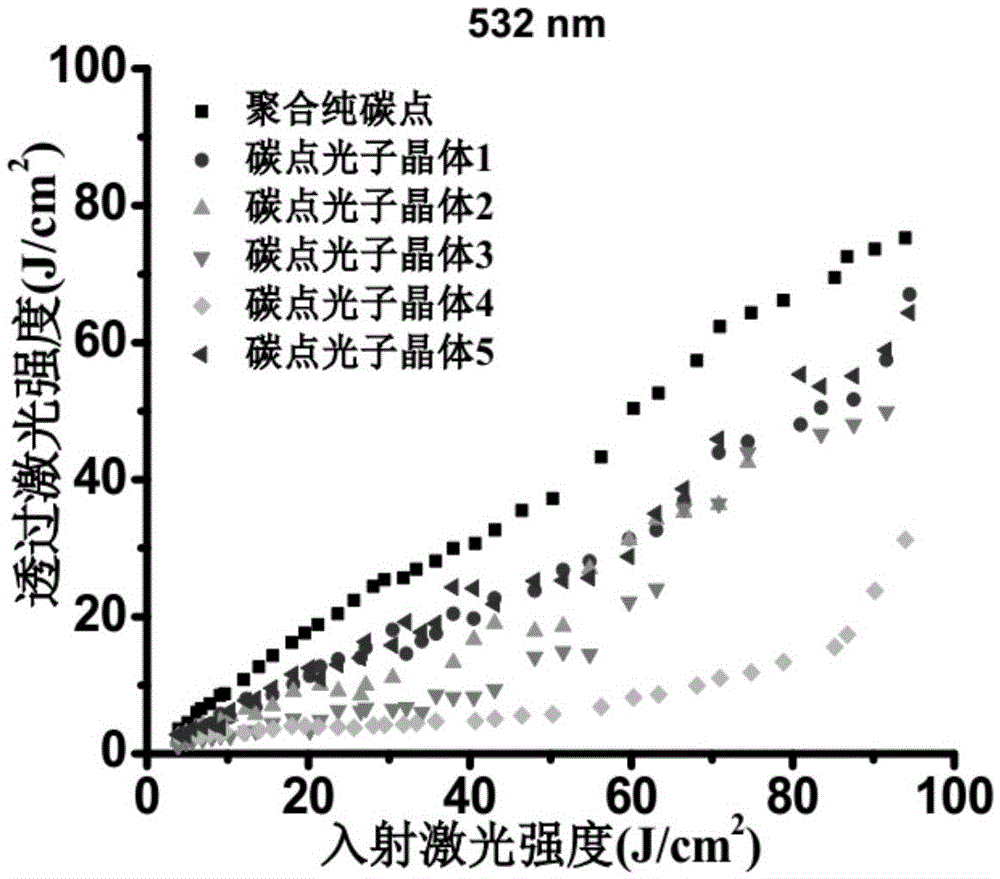Preparation method and application of carbon dot photonic crystal having opal structure or inverse opal structure
An inverse opal structure, photonic crystal technology, applied in crystal growth, chemical instruments and methods, single crystal growth, etc.
- Summary
- Abstract
- Description
- Claims
- Application Information
AI Technical Summary
Problems solved by technology
Method used
Image
Examples
Embodiment 1
[0048] 1. Preparation of core-shell polystyrene microspheres
[0049] Add 1 mass part of methyl methacrylate to 90 mass parts of water, 1 mass part of acrylic acid and 17 mass parts of styrene, then add 0.002 mass part of emulsifier sodium dodecylbenzenesulfonate, and buffer sodium bicarbonate 0.52 parts by mass of the obtained reaction solution; keep the reaction solution at 70°C for 1 hour, then add 0.48 parts by mass of ammonium persulfate aqueous solution, and react at 80°C for 12 hours under continuous stirring conditions to prepare polystyrene microparticles with a core-shell structure. ball.
[0050] 2. Preparation of photonic crystal template
[0051] Pour the polystyrene microsphere emulsion with a particle size of 250nm into a small beaker, place the super-hydrophilic solid substrate vertically in a small beaker filled with a certain concentration of polystyrene emulsion, and place it in a constant temperature and humidity chamber. (temperature: 20° C., humidity: 6...
Embodiment 2
[0059] 1. Preparation of core-shell polystyrene microspheres
[0060] Add 1.2 mass parts of methyl methacrylate to 100 mass parts of water, 1.2 mass parts of acrylic acid and 21 mass parts of styrene, then add 0.004 mass parts of emulsifier sodium dodecylbenzenesulfonate, and buffer sodium bicarbonate 0.55 parts by mass to obtain the reaction solution; keep the reaction solution at 80°C for 2 hours, then add 0.5 parts by mass of ammonium persulfate aqueous solution, and react at 90°C for 15 hours under continuous stirring conditions, and the polystyrene microparticles with a core-shell structure can be prepared. ball.
[0061] 2. Preparation of photonic crystal template
[0062] Pour the polystyrene microsphere emulsion with a particle size of 250nm into a small beaker, place the super-hydrophilic solid substrate vertically in a small beaker filled with a certain concentration of polystyrene emulsion, and place it in a constant temperature and humidity chamber. (Temperature:...
Embodiment 3
[0070] 1. Preparation of core-shell polystyrene microspheres
[0071] Add 0.8 mass parts of methyl methacrylate to 80 mass parts of water, 0.8 mass parts of acrylic acid and 17 mass parts of styrene, then add 0 mass parts of emulsifier sodium dodecylbenzenesulfonate, and buffer sodium bicarbonate 0.5 parts by mass to obtain the reaction solution; keep the reaction solution at 60°C for 0.5 hours, then add 0.45 parts by mass of ammonium persulfate aqueous solution, and react at 70°C for 10 hours under continuous stirring conditions, and the polystyrene microparticles with a core-shell structure can be prepared. ball.
[0072] 2. Preparation of photonic crystal template
[0073] Pour the polystyrene microsphere emulsion with a particle size of 250nm into a small beaker, place the super-hydrophilic solid substrate vertically in a small beaker filled with a certain concentration of polystyrene emulsion, and place it in a constant temperature and humidity chamber. (temperature: 80...
PUM
| Property | Measurement | Unit |
|---|---|---|
| particle diameter | aaaaa | aaaaa |
| percent by volume | aaaaa | aaaaa |
Abstract
Description
Claims
Application Information
 Login to View More
Login to View More - R&D
- Intellectual Property
- Life Sciences
- Materials
- Tech Scout
- Unparalleled Data Quality
- Higher Quality Content
- 60% Fewer Hallucinations
Browse by: Latest US Patents, China's latest patents, Technical Efficacy Thesaurus, Application Domain, Technology Topic, Popular Technical Reports.
© 2025 PatSnap. All rights reserved.Legal|Privacy policy|Modern Slavery Act Transparency Statement|Sitemap|About US| Contact US: help@patsnap.com



